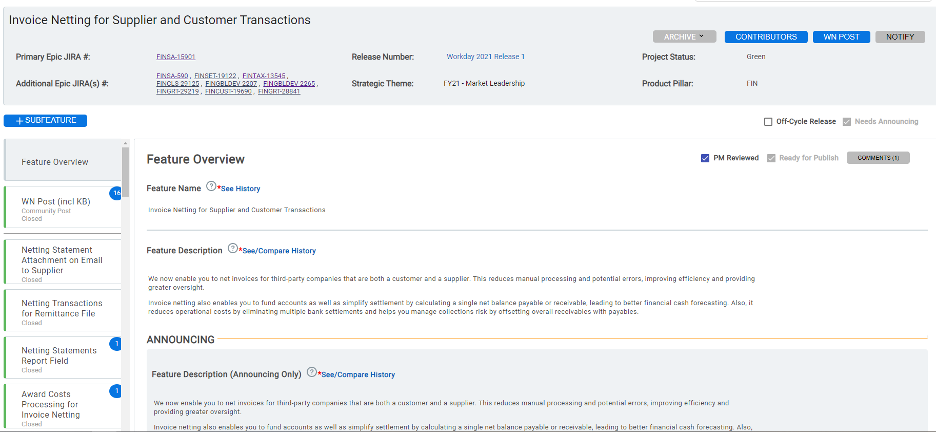The Challenge of Continuous Development in Agile
At Workday, the Information Experience team in technical documentation operates in an Agile continuous development environment, where writers draft, edit, review, and publish documentation on a weekly basis. Teams make significant efforts to stay on top of product changes, collect material from stakeholders, and process content for publication — prioritizing content alignment without sacrificing quality. Everyone who participates in the process has different challenges and goals:
- Writers need to understand the nuances of every feature and translate them into simple English, so customers can quickly assess the impact on their businesses.
- Editors need to refine large volumes of content based on feedback from product managers and other stakeholders.
- Product managers continuously update their development plans and need to notify writers and other stakeholders of feature changes throughout the release.
- Services gather information and determine how new releases will affect customers.
- Content curators process relevant information from stakeholders collaborating on each feature throughout the release and then provide customers with insight into the products.
Everyone was using different tools, such as spreadsheets and email, to draft, review, and publish content, which could lead to problems with version control. Workday needed to redefine and unify the release notes process so that it’s flexible enough to scale with the organization, as well as help writers and other stakeholders maintain consistent messaging without duplication of effort.
A Collaborative Content Development Process
The Information Experience team worked with our developers on a new authoring environment called the What’s New Collaboration tool, which streamlined the process where teams align feature-related content in advance of delivery. Using the tool, the team makes it easier for customers to consume product information following feature updates.
The tool enables stakeholders from across the organization to draft a single source of content that supports multiple purposes and outputs:
- Release notes for customers
- Video posts and presentations for customers
- Configuration Notes for internal partners
The What’s New Collaboration tool offers visibility to all stakeholders. Writers can:
- Write the content for the weekly release notes ahead of time.
- Collaborate with other writers on features that affect multiple teams.
- Notify product managers when the content needs review.
- Prepare feature descriptions for editorial review.
- Manage the workflow status of the documentation to track stages of content development.
- Push the content for publication to the weekly release notes report.
Product managers can:
- Review and change content, then add comments.
- Link a video demonstration of their feature.
Content curators can:
- Create feature posts on Workday Community, a site where Workday experts and customers collaborate to answer questions and propose new ideas for future development.
- Manage additional videos and resources that customers can use to understand the feature in depth.
- Highlight feature delivery dates.
Services can:
- Create posts for internal use to support the implementation and services teams in their effort to set up customers’ tenants.
Insider’s View of the Collaboration Tool

Writers start the documentation process for each feature by creating a separate collaboration form for all enhancements. In the header, writers can organize groups of related features, as well as identify and notify contributors. The form has multiple tabs that cover different aspects of the feature, including benefit statements and setup effort. Throughout the release, stakeholders can add comments on each tab and review each other’s changes to clarify the content. Using the tool, stakeholders can collaborate on one platform, helping maintain a single source of truth for documentation of new enhancements. This effort eventually provides customers with organized, clear, and curated information to assess new functionality.
| The Feature Overview Tab | In the tab, stakeholders can draft, review, and publish feature descriptions that help customers understand why they should implement an enhancement. We also use the feature descriptions when announcing upcoming and highly anticipated updates. |
| New Functionality Subfeatures Tab(s) | Every feature contains 1 or more tabs for subfeatures, where writers describe specific parts of the functionality, from security to setup to reporting. Writers can use the Workflow Status bar to indicate progress on the documentation of each subfeature. Writers can also select the functional area and setup effort for each part of an enhancement. When published, this information helps customers filter the release notes and evaluate new setup requirements.
In the subfeature tabs, writers are able to view and compare different versions of the content throughout the draft process. This enables stakeholders to track changes without losing information. |
| The What’s New Post Tab | Highly anticipated features need additional documentation so that customers can quickly understand their impact. For those features, writers create a What’s New Post tab. The tab provides stakeholders with a centralized place to collate setup requirements, video demonstrations, and additional considerations. Once stakeholders verify the information, content curators publish the What’s New Post on Community, an interactive site designed to help customers deepen their knowledge of Workday applications and maximize their investment.
The What’s New Post covers additional information on what customers need to do to implement a feature and what happens if they decide not to. It also includes links to the customer-generated original feature discussion, demonstrating Workday’s commitment to working on customer-based ideas. In addition, the What’s New Post includes links that direct customers to the Administrator Guide, which describes real-world applications of the features and includes multiple types of information:
|
The Advantage of Collaboration
Using the What’s New Collaboration tool has created a partnership between writers, PMs, Services, and other stakeholders, enabling internal collaboration as we organize and align curated content ahead of feature delivery. In turn, customers are able to save time and resources by leveraging feature documentation to assess the impact and plan testing of new features with every release cycle.

